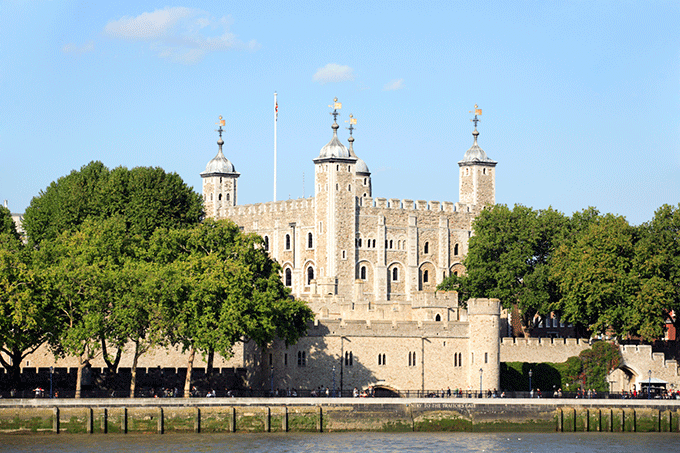Many of British history’s most critical moments have taken place within its wall. We pull back the curtain on the famous medieval castle’s history.

One of London’s most striking landmarks is a medieval castle on the banks of the Thames that has existed here in some form since the year William the Conqueror defeated the English King Harold at the Battle of Hastings in 1066. Knowing he had to secure England’s most powerful city, William ensured he secured a foothold in London by sending an advance guard to construct a fortress from where he could begin his triumphant reign.
Following William’s coronation on Christmas Day at Westminster Abbey in 1066, several strongholds were constructed to protect him against the angry population, with one in the south-east corner of the Roman city on the site of the future Tower of London. These early defences would soon be replaced with a great stone tower in the 1080s – the White Tower – a beacon of the Norman monarch’s supremacy and oppression.
Constructed of Caen stone from William’s native Normandy, the mighty Tower was like no other. It was 118ft x 106ft (36m x 32.5m) across, and 90ft (27.5m) tall on its south side. The Tower dominated the skyline and was protected by Roman walls on two sides, ditches to the north and west up to 25ft (7.5m) wide and 11ft (3.4m) deep. Its primary function was not as a royal residence, although many kings and queens stayed at the Tower. Nor was it the first line of defence against invading armies, though it was more than capable of being so.
By 1100, the castle was being used as a prison, with the first prisoner Ranulf Flambard, who had served William, aiding him in the compilation of the Domesday Book and serving his successor Rufus, before being imprisoned by King Henry I who blamed him for the state of the nation’s finances. Flambard made a daring escape to Normandy and over the years various noblemen were successful in either escaping or bribing the guards at the Tower.
Under the reign of King Richard I (r. 1189-99) further fortifications began. Departing for the Crusades, Richard left the Tower in the hands of his chancellor William Longchamp, Bishop of Ely, who doubled the Tower’s defences. It was a sensible step as Richard’s brother John soon mounted an attack, overcoming the Tower’s formidable walls only after Longchamp ran out of supplies.
On his return to England in 1194, Richard retook the Tower from his regretful brother, who, after begging forgiveness for his treachery, was later named his successor. John’s reign was characterised by political instability, and following his death, John’s son King Henry III succeeded to the throne at the tender age of nine. The boy king’s regents oversaw the building of two new towers and later, seeking refuge from angry barons in the Tower in 1238, Henry decided to further strengthen the castle, building a stupendous curtain wall on the north, east and western sides, reinforced by nine towers and a moat.
Londoners, alarmed at the ever-expanding Tower and the dominance of the monarchy that it represented, were relieved to see a newly built section of the wall collapse near to the Beauchamp Tower. Many believed their guardian angel Thomas Becket – the murdered Archbishop of Canterbury who had carried out repairs at the Tower – had answered their prayers.
In 1258, barons led by Simon de Montfort demanded a reform on the way the country was governed, which led to civil war. De Montfort, a French nobleman, had married the King’s sister Eleanor. But after a bitter family dispute over money, Henry III had threatened to imprison him in the Tower of London. Simon departed first on the Crusades and then to France, returning at the invitation of the rebellious barons. He led the revolt against the King and was declared de facto leader of England from 1263 to 1264 after Henry III surrendered the Tower to him.
Henry’s son King Edward I, in an effort to defeat his father’s rebels, vowed to complete his father’s defensive works, and between 1275 and 1285 he spent a hefty £21,000 transforming the Tower, including adding the infamous Traitor’s Gate. He also began to use the Tower as a secure storage place for official papers and valuables, establishing the Royal Mint here – it would remain here until 1812 – while it also became home to much of the monarch’s jewellery from 1303 after pieces were stolen from Westminster Abbey. The monarch’s crown, orb and sceptres remained stored at Westminster until 1649.
The Tower has been the scene of some of history’s most brutal encounters. In 1381 10,000 rebels under Wat Tyler burned and pillaged the capital and an unarmed mob forced their way into the Tower. Simon of Sudbury, the Archbishop of Canterbury, was one of those dragged out and murdered on Tower Hill during the Peasants’ Revolt. His body was later buried in Canterbury Cathedral.
In 1483 the sons of King Edward IV, 12-year-old Edward V and his younger brother Richard, were sent to the Tower by their uncle, the Duke of Gloucester. They had been declared illegitimate when the Duke was crowned King Richard III. The princes were never seen again, and popular myth sees king-in-waiting Richard III as their executioner. Two skeletons discovered in front of the White Tower in 1674, and examined in 1933 were found to be those of two boys, aged about 10 and 12. A plaque commemorating the princes marks the site today.
In Tudor times, the Tower was a vital meeting point for kings and queens, and in 1485, King Henry VII founded the now iconic Yeomen Warders, the ceremonial guards of the Tower. They are known as ‘Beefeaters’ due to their position in the Royal Bodyguard, which allowed them to eat as much beef as they wanted from the king’s table.
Perhaps mostly famously, two of King Henry VIII’s wives were executed at the Tower. This included his second wife Anne Boleyn, who was taken to the Tower under charges of treason and beheaded on Tower Green in 1536 by a swordsman brought specially from France. Six years later, Henry’s fifth wife Catherine Howard followed, sentenced to death for adultery in 1542.
After the Reformation under King Henry VIII, his daughter ‘Bloody’ Queen Mary I (r. 1553-8) returned the country to Catholicism and her short reign saw many Protestant figures imprisoned at the Tower. One of these was Lady Jane Grey, ‘the Nine Days’ Queen’, who was executed at the Tower on the Queen’s orders; and Princess Elizabeth, the Queen’s half-sister was imprisoned there (before later becoming Queen Elizabeth I).
One date that no one in England will ever forget is 5 November 1605, the evening of the Gunpowder plot led by the Catholic Guy Fawkes. His failed attempts to blow up King James I and Parliament saw him taken to the Tower where he was tortured and later hung and quartered at Old Palace Yard, Westminster.
King Charles I’s reign (r. 1625-49) ended in a long and bloody civil war (1642-9) which left its mark on the Tower, and in particular, the Crown Jewels. Following King Charles I’s execution in 1649, orders were given to destroy the Crown Jewels. Oliver Cromwell, Lord Protector from 1653, installed the Tower’s first permanent garrison. Under the restored monarchy, the Tower became the base of the Office of Ordnance, which provided military equipment while a new Crown Jewels went on display.
With such royal treasures on offer, it was little surprise that this would incite thieves to strike. In 1671 a Colonel by the name of Thomas Blood and his gang overpowered an elderly jewel housekeeper, tied him up, beat and stabbed him before crushing the Imperial State Crown and hiding it under his cloak. Blood and his gang were arrested and, strangely, pardoned by a merciful King Charles II.
In 1841, a fire ripped through the Tower, destroying the Grand Storehouse that was subsequently rebuilt by the then Constable of the Tower, the Duke of Wellington.
Over the years The Tower has served variously as a prison, an armoury, a treasury, the Royal Mint, a public records office, as well as home to the Jewels. Perhaps less well-known is that it also served as a menagerie. King John is believed to be the first king to keep lions and other exotic animals there, while in 1251 a polar bear was acquired. The Tower Menagerie was closed in 1835 with the animals transferred to the new London Zoo.
Today’s iconic medieval appearance is in part thanks to England’s 19th-century fascination with such bloody periods of history. Gothic revival architect Anthony Salvin transformed the Beauchamp Tower, refaced the exterior walls and replaced battlements. He made improvements to the Salt Tower and Wakefield Tower, building a bridge between it and St Thomas’s Tower.
Visitors today can see the Coronation spoon, the Sovereign’s sceptre with cross and its 530.2 carat Great Star of Africa diamond, as well as the Imperial State Crown made in 1937, and the solid gold St Edward’s Crown.
The last hanging took place on Tower Hill in 1780 and a number of high-profile prisoners were locked in the Tower including Second World War prisoners – the most notorious being Rudolf Hess, albeit for four days only.
Finally, a Gothic tale is that of the Tower ravens who have been protected since the time of Charles II and legend says the kingdom and the Tower will fall if the six resident ravens ever leave the fortress. Given that it has stood for almost 1,000 years, it would take one mighty army.
Related articlesHistory of the Great Fire of London |
Click here to subscribe! |
Download BRITAIN Magazine to your mobile today

 No mobile device? Purchase directly on Zinio for your desktop!
No mobile device? Purchase directly on Zinio for your desktop!





 © 2024
© 2024